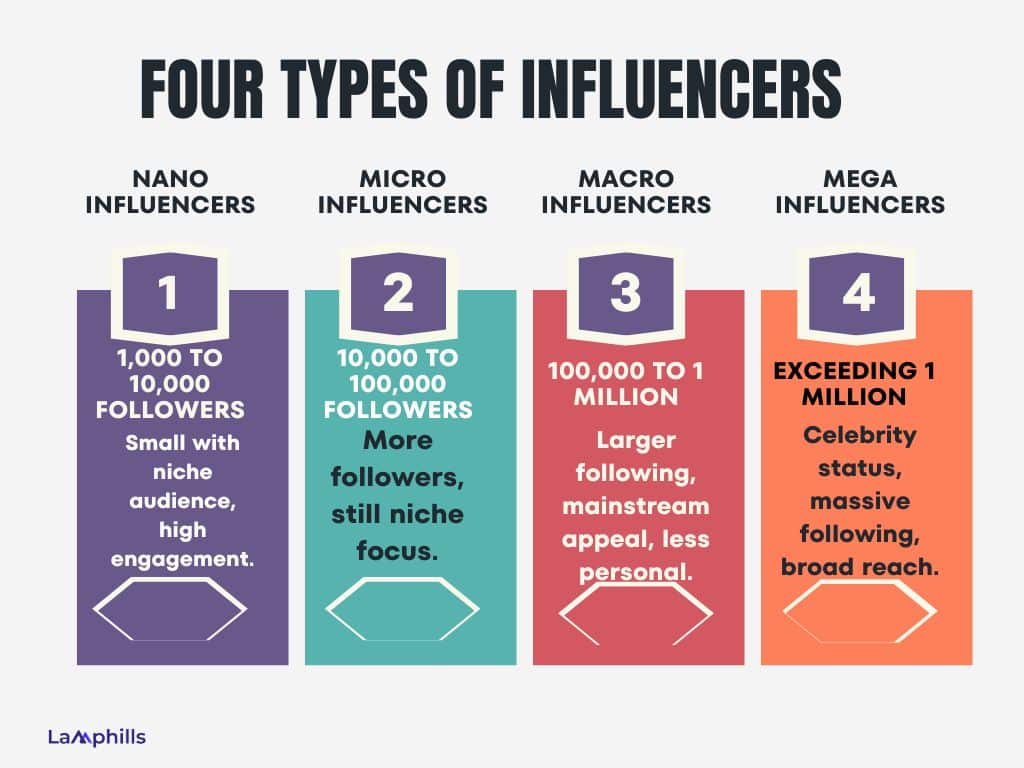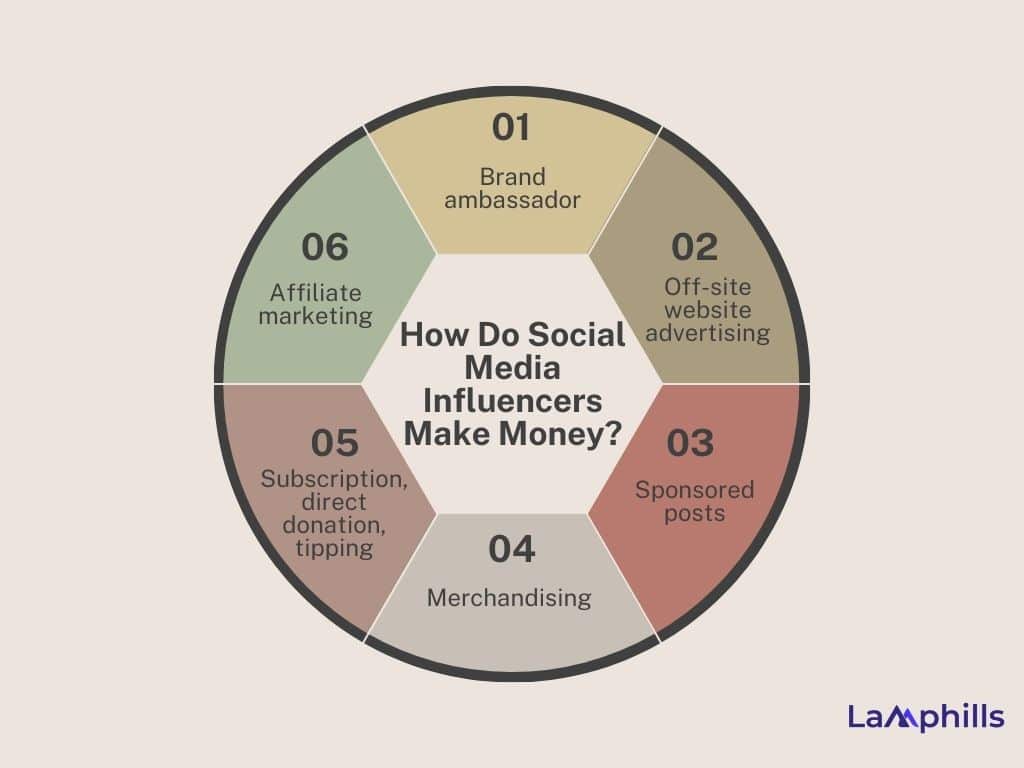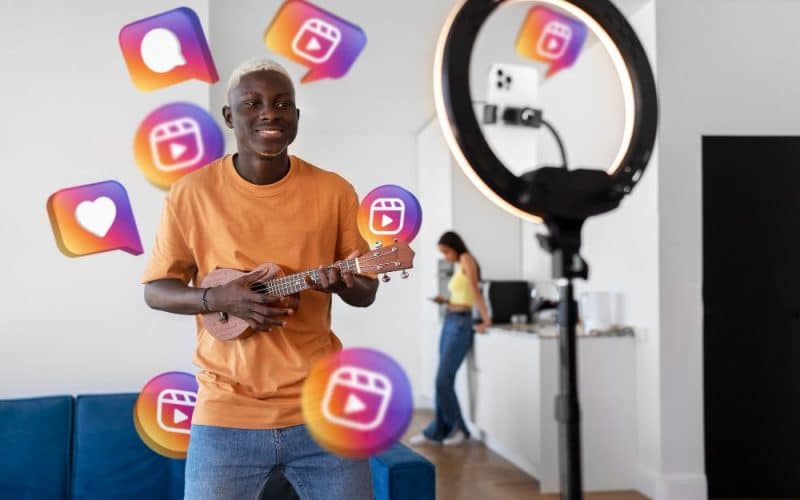How much do social media influencers make? I mean, they are very popular and all, with some of them even known all over the world, but what do their finances look like? How are they able to maintain their high-profile lifestyles without having to work 9-5?
Also, do they get paid a lot because they are immensely popular, or do their popularity and influence come because they earn a lot? Now, that is a valid question.
Key Takeaways
- A social media influencer is a personality who influences their audience to purchase the products or services they promote.
- Some of the most common methods of separating the different types of influencers are by follower numbers, by types of content, and by the level of influence.
- Social media influencers’ earnings are determined by who they are and their demographics, engagement rates, platform, and follower counts.
- Influencers’ earnings range from $195 per post for nano-influencers to $1,804 per post for macro-influencers.
- According to HypeAuditor, on average, influencers earn $2,970 monthly or $35,640 annually. Mega-influencers can earn as much as $15,356 monthly or $184,272 annually.
Who Is A Social Media Influencer?
A social media influencer is a personality who influences their audience to purchase the products or services they promote. They are people who have built a reputation for their knowledge and expertise on a specific topic. They make regular posts about that topic on their preferred social media channels and generate large followings of enthusiastic, engaged people who pay close attention to their views.
Brands love social media influencers because they can create trends and encourage their followers to buy products they promote.
Over the last decade, we have seen social media grow rapidly in importance. According to the most recent statistics, the number of global social media users in 2024 is 5.04 billion, indicating a 3.1% rise from the previous year. A number that is still expected to rise, as shown in the image below.

Inevitably these people look up to influencers on social media to guide them with their decision making.
Types of Influencers
Some of the most common methods of separating the different types of influencers are by follower numbers, by types of content, and by the level of influence. Influencer marketing platforms, serving as intermediaries between brands and influencers, further facilitate this categorization and streamline collaboration in the evolving landscape of influencer marketing.
You can also group influencers by the niche in which they operate. This means that influencers who may appear in a low category by one measure may seem more influential when looked at in another way. For example, many mega-influencers are also celebrities. Yet both these groups often have less real influence on their audience because they lack expertise in a dedicated narrow niche.

Nano-Influencers
These people only have a small number of followers, but they tend to be experts in an obscure or highly specialized field. You can think of nano-influencers as being the proverbial big fish in a small pond.
Nano Influencers have between 1,000 and 10,000 followers. Regardless, these are keen and interested followers, willing to engage with the nano-influencer and listen to their opinions.
While many brands would consider nano-influencers as being inconsequential, they can be of extreme importance to firms that make highly specialized and niche products. For most firms, however, nano-influencers probably lack sufficient influence to be of much use. They may be cheap and carry tremendous sway with a small number of people, but in most niches, you would need to work with hundreds of nano-influencers to reach a broad audience.
Micro-Influencers
Micro-influencers are ordinary everyday people who have become known for their knowledge about some specialist niche. As such, they have gained a sizable social media following amongst devotees of that niche. Of course, it is not just the number of followers that indicates a level of influence; it is the relationship and interaction that a micro-influencer has with his or her followers.
Although views differ, you could consider micro-influencers as having between 10,000 and 100,000 followers on a single social platform.
Micro-influencers have built up specialist followings, and they will not want to harm their relationship with their fans if they are seen to promote a lemon. This requirement for the relationship between micro-influencers and brands to align with target audiences means that influencers are often picky about with whom they work. Some micro-influencers are happy to promote a brand for free. Others will expect some form of payment.
Regardless of the price, any influencer is unlikely to want involvement with an “inappropriate” brand for their audience.
Over 35% of influencers have been building an audience for over four years and 21% earn over $50k annually. However, the majority of creators identifying themselves on the internet today fall into the nano or micro tier. The majority of campaign power comes not from mega influencers with huge audiences, but actually the influencers with a smaller following, higher engagement, and developed relationships with their audience.
In all reality, micro-influencers are the influencers of the future.
Macro-Influencers
Macro-influencers are one step up from micro-influencers and may be more accessible as influencer marketers. The number of their followers typically ranges between 100,000 and 1 million followers on a social network.
This group tends to consist of two types of people. They are either B-grade celebrities, who haven’t yet made it to the big time. Or they are successful online experts, who have built up more significant followings than the typical micro-influencers. The latter type of macro-influencer is likely to be more useful for firms engaging in influencer marketing.
Macro-influencers generally have a high profile and can be excellent at raising awareness. There are more macro-influencers than mega-influencers, so it should be easier for a brand to find a macro-influencer willing to work with them. They are also more likely to be used to working with brands than micro-influencers, making communication easier.
However, you do need to be careful with this level of influencer. This is the category most likely to engage in influencer fraud – some have only reached their position thanks to the followers they have purchased.
Mega-Influencers
Mega influencers are people with a vast number of followers on their social networks. Although there are no fixed rules on the boundaries between the different types of followers, a common view is that mega-influencers have more than 1 million followers on at least one social platform.
Many mega-influencers are celebrities who have gained their fame offline – movie stars, sportspeople, musicians, and even reality television stars. However, mega-influencers can also gain vast followings through their online and social activities.
Only major brands should approach mega-influencers for influencer marketing. Their services will be costly, and they will most likely be extremely fussy about with whom they choose to partner. In virtually every case, mega-influencers will have agents working on their behalf to make any marketing deals.
How Much Do Social Media Influencers Make?
As brands turn to more social media marketing avenues, they’re finding that influential content creators return an excellent return on investment (ROI).
Brands are also willing to pay for that credibility. Social media influencers can rake it in, but how much they earn is tied to who they are and their demographics, engagement rates, platform and follower counts.
Average earnings across all platforms
According to Influencer Marketing Hub’s report, here are the average per-post payments social media stars receive across various platforms:
- Nano-influencers. Nano-influencers have 10,000 or fewer followers and earn about $195 per post.
- Midtier influencers. Midtier influencers have 10,000 to 1 million followers and earn about $1,221 per post.
- Macro-influencers. Macro-influencers have over 1 million followers and earn about $1,804 per post.
Influencer marketing platform HypeAuditor looked into Instagram influencers’ monthly and annual earnings and found the following averages:
- Overall monthly and annual earnings: HypeAuditor found that, on average, influencers earn $2,970 monthly or $35,640 annually.
- Nano-influencer monthly and annual earnings: Nano-influencers earn about $1,420 per month or $17,040 annually.
- Mega-influencer monthly and annual earnings: Mega-influencers earn about $15,356 monthly or $184,272 annually.
Whether it’s brand sponsorships or freelancing, there’s money to be made in the content creation space and plenty of ways to earn it. So, whether you’re just starting out, or venturing into full-time creator status, here are several tips for you to make money as a social media influencer:
How To Make Money As A Social Media Influencer
What Affects Social Media Influencer’s Earnings?
Of course, the numbers cited above are averages. Various factors can affect social media influencer’s earnings, including the following:
Follower counts
Influencers’ audience size is a crucial factor in what they earn. On Instagram, the general pay rate rule of thumb is $100 for every 10,000 followers. Influencers with extremely large followings, in the tens or hundreds of millions, earn significantly more. For example, according to Influencer Marketer Hub, Kendall Jenner has around 292 million Instagram followers and charges between $568,595 and $947,659 per post.
For comparison, Zeenat Aman, a former Bollywood actress and current Instagram influencer, has 253,009 followers and charges between $765 and $1,275 per post.
The influencer’s involvement
The more involved the influencer is in promoting the product, the higher the rate. So, a sponsored post where the influencer writes a blurb encouraging followers to try the product may be charged a lower rate, while a video demonstration of the product would command a higher rate.
Influencers’ audience engagement rate
Influencers with highly engaged audiences also can charge more. However, follower count can trump engagement rate. For example, while Jenner’s engagement rate is only 1.14 percent, her huge following justifies the cost for major brands.
How Do Social Media Influencers Make Money?

Brand Ambassador
A brand ambassador partnership is an agreement between an influencer and a company. The influencer typically agrees to promote the company’s products or services, often exclusively. Or generally, be affiliated with the brand.
In exchange for their endorsement, the company provides the influencer with compensation. This can take the form of cash, free products, or other perks.
As an influencer, you can make money off these partnerships. You can charge a per-post fee, receive a percentage of sales, or even have a salary. The amount of money an influencer can make varies depending on their following and engagement rates.
Off-site website advertising
Off-site website advertising is another type of online marketing. It involves promoting a brand or product on a website or platform that is not the product’s home page.
For example, let’s say I sell buttons and reach out to you, an influencer, to write a blog post reviewing my product. I pay you a predetermined amount for every lead I get from your post.
Sponsored posts
Sponsored posts are one of the most popular ways for influencers to make money. A sponsored post is when an influencer gets paid to post about a product or service on their page. When an influencer vouches for a brand, their followers are more inclined to trust that brand.
You’ll see the ‘Paid Partnership’ tag below the influencer’s name for sponsored posts on Instagram.
Often, influencers with a larger reach can charge more for sponsored content. What you can make off of sponsored posts typically depends on:
- your following size
- the industry you’re in
- how well you market your services
Here are two general rules to measure your rates:
- Engagement rate per post + extras for type of post (x #of posts) + extra factors = total rate
- The unspoken industry standard is $100 per 10,000 followers + extras for type of post (x # of posts) + additional factors = total rate
Off-site website advertising is also achieved through:
- banner ads
- sponsored posts
- links in the sidebar of a blog
Influencers can make money off of this type of advertising by charging for ads placed on their site. Or by earning a commission on sales generated from clicks on the ad.
Some influencers also offer consulting services. These can help brands maximize their reach and effectiveness with off-site website advertising.
Merchandising
Merchandising is a term used in marketing and retail. It refers to the range of activities that promote the sale of products to customers. When we talk about influencers merchandising, we’re talking about influencers producing merchandise for their brand.
This can be anything from Kylie Jenner’s lip kits to a photography influencer selling prints.
Merchandising can be a very lucrative revenue stream, especially for influencers with a dedicated following.
Direct donation, tipping, subscriptions
Subscriptions are probably the most well-known of the three. By subscribing to someone, you’re essentially paying them a monthly fee in exchange for access to their content. This can be anything, from exclusive videos and photos to behind-the-scenes looks at their life and work. Influencers can incentivize subscriptions by offering discounts or freebies to those who sign up. For example, they may offer a free month of content for every six months that you subscribe.
Patreon is a popular subscription-based platform. Influencers can offer tiered levels to subscribers. Each tier can have different, exclusive, and interesting content.
We also have donations, which are usually made to charity or GoFundMe-type campaigns. However, fans can also give them directly to an influencer. Donations are completely voluntary, and there is no expectation of anything in return. Many influencers may offer perks like shoutouts or signed merchandise as a thank-you.
Tipping is similar to a subscription in that it’s a way of showing support for someone’s work. However, instead of paying a monthly fee, one simply makes a one-time donation. Many influencers include their PayPal or Venmo tipping information when doing Live Streams. They might attach it to their bios or websites or even just ask in a post.
Tipping is often reserved for content creators who produce high-quality work. So it’s more like a bonus than a necessity, as you’ll be creating the work regardless. Nonetheless, your followers know it’s always appreciated.
Affiliate marketing
Affiliate marketing is a type of performance-based marketing. A business rewards affiliates for each customer brought by the affiliate’s marketing efforts. In this case, the affiliate is you, the influencer.
You can expect to generally make 5-30% commission in affiliate marketing contracts. Often, bigger influencers are in the 8-12% range.
Have you seen influencers who promote a discount on a product or service with a personalized code or URL? Those people are likely affiliate marketers. They want to incentivize sales and track customers, so they can get paid a certain amount per sale.
You can make a significant amount of money through affiliate marketing. How much you make will depend on:
- the affiliate contract you’ve worked out
- the number of followers you have
- the number of brands you’re working with
How Much Do Facebook Influencers Make?
Facebook might be trending out of favor with a younger demographic. But it is still a social media giant, the largest by many metrics. Facebook influencers are still pulling in money from things like:
- sponsored posts
- brand ambassador contracts
- affiliate marketing
- merchandising
- Live videos promoting products or services
Here are According to Statista,
- Nano-influencers can make $170 per post on Facebook
- Micro-influencers can make $266 per post on Facebook
How Much Do Influencers Make On Instagram?
Instagram and influencers are inextricably linked. The Meta-owned social media site has emerged as a critical venue for influencers just starting. And they don’t need millions of Instagram followers to make money.
When Insider chatted with influencer Alexa Collins last year, she charged upwards of $1,000 for a sponsored story on Instagram, despite having over one million followers. Meanwhile, micro-influencer Tyler Chanel charges $100 for an Instagram story, increasing the cost depending on the topic and deliverables.
Getting established a career as a creator is no longer just a dream as more firms look to smaller producers like “nano” or “micro” influencers with less than 100,000 followers. However, earning money on Instagram is not as simple as it appears. Instagram, unlike YouTube, does not currently have a payment structure akin to YouTube’s Partner Program. Generally, influencers depend on sponsored content to make a living out of it. Sponsored content takes numerous forms, from posting a picture to the main feed with #ad to sharing swipe-up links.
These types of brand bargains come at a variety of prices. Some influencers use algorithms to arrive at these figures, such as charging firms $100 for every 10,000 followers. However, not everyone agrees on the same formula.
Each transaction must consider an influencer’s following, engagement metrics, and niche, as well as additional considerations such as exclusivity, usage rights, and timing.
On the other hand, brand partnerships can result in enormous payouts if influencers negotiate correctly. For example, one influencer told Insider that she had already booked $700,000 in brand partnerships halfway through 2021.
How Much Do Influencers Make On Twitter?
Twitter appears to be the least lucrative platform for influencers. It could have something to do with other apps having eCommerce integration. Or it might have something to do with engagement levels.
But, many influencers will offer package deals. A sponsored Tweet can be used as a piece of content that sweetens the deal.
Here are Twitter influencers’ general earnings per post according to Statista:
- Nano-influencer can make $65
- Micro-influencers and above can make $125
Influencer content on Twitter will often be sponsored posts or use brand-specific hashtags. Twitter Takeovers are also a potential revenue stream.
How Much Do TikTok Influencers Make?
TikTok influencers overtook Facebook in 2022 and YouTube in 2024 in popularity. So, it might be a good idea to start building your following on TikTok now. The app’s only growing stronger.
According to this Statista report:
- Nano-influencers can make $181 per TikTok video
- Macro-influencers can make $531 per TikTok video
- Mega-influencers can make between $1,631 and $4,370 per TikTok video
Influencers on TikTok will often create sponsored video content to promote a brand. Brands can host ‘Takeovers’, giving an influencer control of their account for a set amount of time. Or, they can monetize their own account with Gifts.
Recommended Articles
- How to Do Social Media for Nonprofits (All You Need)
- Best Social Media Customer Service Practices for 2024 (Detailed Guide)
- Social Media Engagement: 7 Interactive Post Ideas That Helped Us.
- How Can You Protect Yourself On a Social Networking Site?
- Where To Hire The Best Social Media Experts In 2024
- External Communication In Business: Strategies for Amplifying Your Business Voice





